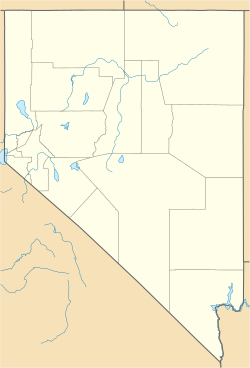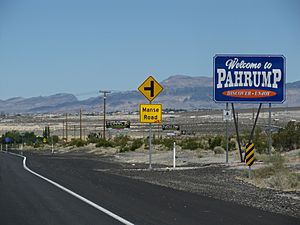Pahrump, Nevada facts for kids
Quick facts for kids
Pahrump, Nevada
|
||
|---|---|---|
| Town of Pahrump | ||

Aerial view of Pahrump
|
||
|
||

Location of Pahrump in Nye County
|
||
| Country | ||
| State | ||
| County | ||
| Government | ||
| • Type | County commission | |
| Area | ||
| • Total | 328.94 sq mi (851.96 km2) | |
| • Land | 328.80 sq mi (851.59 km2) | |
| • Water | 0.14 sq mi (0.37 km2) | |
| Elevation | 2,697 ft (822 m) | |
| Population
(2020)
|
||
| • Total | 44,738 | |
| • Density | 136.06/sq mi (52.53/km2) | |
| Demonym(s) | Pahrumpian | |
| Time zone | UTC−8 (Pacific (PST)) | |
| • Summer (DST) | UTC−7 (PDT) | |
| ZIP Codes |
89041, 89048, 89060, 89061
|
|
| Area code(s) | 775 | |
| FIPS code | 32-53800 | |
| GNIS feature ID | 0845593 | |
Pahrump (/pəˈrʌmp/ PƏ-rump) is an unincorporated town located in Nye County, Nevada, United States. It is about 50 miles (80 km) west of Las Vegas, which is roughly an hour's drive away. Pahrump is very close to the Nevada–California border. In 2020, the town had a population of 44,738 people.
Contents
History of Pahrump
Early Inhabitants and Settlement
Pahrump was first home to the Southern Paiute people. Later, in the late 1800s, settlers slowly began to move into the area. They named the town Pahrump after the Southern Paiute name Pah-Rimpi, which means "Water Rock." This name was chosen because there were many artesian wells in the valley. Artesian wells are natural springs where water flows up from underground.
Because of these wells, the new settlers started large ranches in the Pahrump Valley. Many of these ranches were bigger than 1,000 acres (400 ha). On these ranches, farmers grew alfalfa and cotton, and they also raised livestock like cows.
Growth and Modern Connections
Until the 1960s, Pahrump was quite isolated. It had no regular telephone service, only a special radio phone in a small market. Also, there were no paved roads leading into or out of the Pahrump Valley.
As the nearby city of Las Vegas grew, Pahrump also started to develop. More people moved to the area, and new homes were built. This growth led to important changes in the late 1960s:
- Telephone service was finally brought to Pahrump.
- A paved highway (now NV 160) was built, connecting Pahrump to Las Vegas.
Later, this road was extended north to US 95. Another paved road (NV 372) was built, linking Pahrump to Shoshone, California. This new road made it easier to travel to the Death Valley area and provided a shorter way to get to Los Angeles and other parts of California.
Education and Community Development
In the 1950s and 1960s, Pahrump had a small two-room elementary school. Older students had to travel to Shoshone for high school. However, in 1974, Pahrump got its very own high school, called Pahrump Valley High School.
Pahrump is a good example of an exurb. This means it's a residential area located beyond the suburbs of a larger city. Most of the large farms in the valley have closed down. Over the years, the underground water sources have been used up. The growth of homes in Pahrump helped make Nye County one of the fastest-growing counties in the United States in 2005.
Interesting Events in Pahrump
In 1998, a large treasure of silver belonging to Las Vegas casino owner Ted Binion was found buried in a secret underground vault in Pahrump.
On November 4, 2017, a special event happened on Nevada State Route 160 near Pahrump. The Koenigsegg Agera RS, a very fast car, reached a top speed of 277.9 miles per hour (447.2 km/h). This set a new record for the highest top speed of a production car at that time.
Geography and Climate
Location and Size
Pahrump is located in the Mojave Desert. According to the United States Census Bureau, the area of Pahrump is about 298 square miles (771.5 km²). All of this area is land. Pahrump is the largest census-designated place (CDP) in the main part of the United States.
Weather in Pahrump
Pahrump has a desert climate.
- Summers are usually very hot and dry. Temperatures often reach around 100°F (38°C) and sometimes even 110°F (43°C). However, nights are much cooler, often dropping to the mid-60s or 70s °F (around 20°C). This is because Pahrump is in a valley, which allows the heat to escape quickly after sunset.
- Winters are generally mild. Daytime temperatures are usually in the 50s and 60s °F (10s °C). At night, temperatures often drop to around freezing (0°C) between December and February.
- Spring brings pleasant warm days and cool evenings. It is also the windiest time of the year.
- Snowfall is rare in Pahrump, but it usually snows at least once a year.
Pahrump's elevation helps protect it from the extremely hot summer temperatures found in nearby Death Valley.
Population and People
How Pahrump's Population Grew
Pahrump has grown a lot over the years. Here's how its population has changed:
- 1990: 7,424 people
- 2000: 24,631 people
- 2010: 36,441 people
- 2020: 44,738 people
As of the year 2000, there were 24,631 people living in Pahrump. There were 10,153 households, and 7,127 families. The average household had about 2.42 people. The average family had about 2.83 people.
The population was spread out in terms of age:
- 22.3% were under 18 years old.
- 55.3% were 65 years old or older.
The average age in Pahrump was 45 years.
Education
Schools and Learning in Pahrump
Public schools in Pahrump are managed by the Nye County School District. The main office for the school district is located in Pahrump.
Pahrump also has a public library where people can borrow books and learn. For older students, Great Basin College serves the county, offering higher education opportunities.
Economy
Businesses and Activities
Pahrump has several notable businesses. One is the Spring Mountain Motor Sports Ranch, which is a place for car racing and driving experiences. Golden Entertainment also runs three casinos in Pahrump, offering entertainment and gaming.
Media
Local TV and Radio
Pahrump has its own local TV station, KPVM-TV 25. This station offers several digital channels with different types of shows. Pahrump is also home to KACP 103.1 FM, a radio station that plays country music.
Transportation
Getting Around Pahrump
Pahrump Valley Transportation is the main public transportation service in Pahrump. There is also VetRANS, which provides transportation for veterans. Both services require appointments. They can also take people to certain places in Las Vegas.
For longer trips, Salt Lake Express has a bus route that stops in Pahrump, traveling between Las Vegas and Reno. The Eastern Sierra Transit Authority offers bus service from Pahrump to Tecopa, California.
For air travel, residents and visitors use McCarran International Airport in Las Vegas, which is about 60 miles (97 km) east of Pahrump. Pahrump also has a small private airport called Calvada Meadows Airport. However, planes need to ask for permission before landing there. If you need to rent a car, Enterprise Rent-A-Car has a local office. Pahrump also has taxi services available 24 hours a day.
Notable Residents
Famous People Who Lived in Pahrump
Many interesting people have lived in Pahrump:
- Art Bell was a famous author and radio host. He created Coast to Coast AM, a popular overnight radio show that talked about paranormal topics, mysteries, and other strange things. He often broadcasted the show from his home studio in Pahrump. Art Bell passed away in Pahrump in 2018.
- Michael Jackson bought a home in the area in 2008. He briefly had a home studio there and homeschooled his three children.
- Ronald Wayne is the third co-founder of Apple Computer, along with Steve Jobs and Steve Wozniak. He sold his share in Apple for $800 in 1976. Today, he lives a quiet life in Pahrump, selling stamps and rare coins.
- Retired actress June Kenney lived in Pahrump from 2010 until her death in 2021.
- The musical group Escape the Fate was formed in Pahrump before they moved to Las Vegas.
Images for kids
See also
 In Spanish: Pahrump (Nevada) para niños
In Spanish: Pahrump (Nevada) para niños






